

Wintergatan - Marble Machine (music instrument using 2000 marbles) Firstvision. Piper Computer Kit - award winning STEM learning toolbox. Frequently Asked Questions.
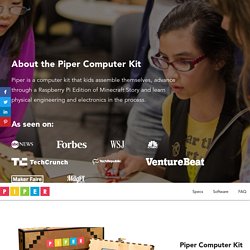
These tattoos conduct electricity, turning you into a very basic cyborg. Créer un serveur de partage de fichiers sur un Raspberry Pi. HeK - Virtual reality for 3D glasses. CACBretigny Vocales DP. Robotshop rover development manual. Comment fabriquer un Robot - Leçon 10 : Programmer votre robot - Blogue RobotShop. Index des leçons : La programmation est généralement la dernière étape concernant la fabrication d’un robot.
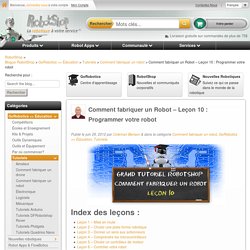
Si vous avez suivi les leçons, vous avez à présent choisi les actionneurs, l’électronique, les capteurs et autres, et vous avez assemblé le robot et, avec de la chance, il ressemble à quelque chose qui correspond à ce que vous aviez initialement décidé de construire. Sans programmation, le robot n’est qu’un presse-papiers coûteux bien que très agréable à regarder. Il faudrait bien plus d’une leçon pour vous apprendre à programmer un robot donc, à la place, cette leçon vous aidera dans la façon de commencer et sur où (et quoi) apprendre. L’exemple pratique va utiliser « Proccessing », un langage de programmation amateur populaire destiné à être utilisé avec le microcontrôleur Arduino choisi au cours des précédentes leçons. Robotshop rover development manual. Run From mBlock IDE or Upload to Board – Open-source Arduino Robot Building Platform.
If you haven’t yet downloaded mBlock, installed Arduino drivers or connected your board, you might want to take a look at this lesson first. mBlock programs can be run from 2 places: the mBlock interface or the robot board.
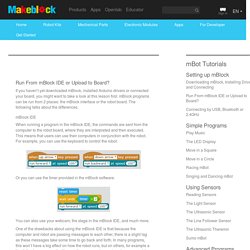
The following talks about the differences. mBlock IDE When running a program in the mBlock IDE, the commands are sent from the computer to the robot board, where they are interpreted and then executed. This means that users can use their computers in conjunction with the robot. For example, you can use the keyboard to control the robot: Un timelapse pas comme les autres… Time-lapse avec Raspberry Pi et sa (Pi)caméra. Un timelapse pas comme les autres… Raspicam Générateur de Ligne de Commande. An introduction to the Gertbot. A look at the hardware capabilities and software support for the Raspberry Pi robotics board.
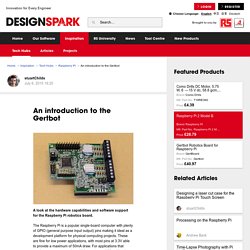
The Raspberry Pi is a popular single-board computer with plenty of GPIO (general purpose input output) pins making it ideal as a development platform for physical computing projects. These are fine for low power applications, with most pins at 3.3V able to provide a maximum of 50mA draw. For applications that require more power, such as driving motors, additional hardware is needed. Enter the Gertbot: an add-on module for the Raspberry Pi that plugs directly on to the GPIO pins. Projects. Nocturnal Wildlife Watching with Pi NoIR. Using the new Raspberry Pi camera for time-lapse photography of creatures that move in the night. The CMOS sensor used in the Raspberry Pi Camera is by default sensitive to infrared, and so it's normally paired with a filter that blocks this so that it responds to light in the same way that our eyes do and colours look natural. The soon-to-be-released Pi NoIR is essentially the original Raspberry Pi camera albeit without this infrared-blocking filter fitted (no IR, noir, get it?)
The extended spectral range of the Pi NoIR means that it can be put to use in all manner of interesting applications. An automatic self-portrait camera using Raspberry Pi. Combining the Pi, Camera Module, Python and OpenCV for a fun demo Computer vision is an exciting field that is becoming increasingly accessible through advances in both hardware and software.

In days past it would have been inconceivable to fit the computing power required into a family home, let alone something as small as the Raspberry Pi. As part of the Raspberry Pi Day hosted by RS, celebrating the launch of the Raspberry Pi 3, and four years of the Raspberry Pi Foundation, we decided to build something to show off the Pi performing face detection. This post covers the hardware and software elements of the project, including the use of Python OpenCV libraries, doing the heavy lifting for the face detection. Ingredients It was proposed that the system should incorporate the following: Building custom capacitive interfaces with Electric Paint.
Using the Touch Board as a USB HID peripheral with the Raspberry Pi 2.
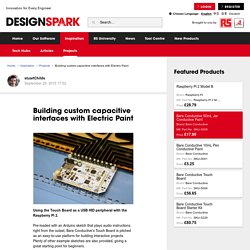
Pre-loaded with an Arduino sketch that plays audio instructions right from the outset, Bare Conductive's Touch Board is pitched as an easy-to-use platform for building interactive projects. Plenty of other example sketches are also provided, giving a great starting point for beginners. Whilst it is possible to connect all manner of conductive materials to the Touch Board, it was originally designed to make it easier to build interfaces with Electric Paint. Based on the Arduino Leonardo, it has the ability to be used as a HID (Human Interface Device) – like a normal keyboard or mouse – to control any computer with a USB port. OSMC.
Building custom capacitive interfaces with Electric Paint. Projects. DenseCap: Fully Convolutional Localization Networks for Dense Captioning. We introduce the dense captioning task, which requires a computer vision system to both localize and describe salient regions in images in natural language.
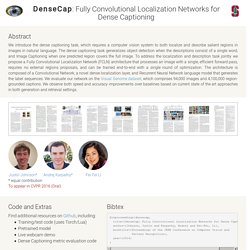
The dense captioning task generalizes object detection when the descriptions consist of a single word, and Image Captioning when one predicted region covers the full image. To address the localization and description task jointly we propose a Fully Convolutional Localization Network (FCLN) architecture that processes an image with a single, efficient forward pass, requires no external regions proposals, and can be trained end-to-end with a single round of optimization.
The architecture is composed of a Convolutional Network, a novel dense localization layer, and Recurrent Neural Network language model that generates the label sequences. Blockly@rduino. Doug. Apprendre à coder et programmer : 50 ressources pour les enfants et les ados. Cours en ligne, applications, ateliers, livres, robots, kits… Alors que la programmation débarque dans les programmes du collèges et lycée, voici plus de 50 ressources pour apprendre à coder.
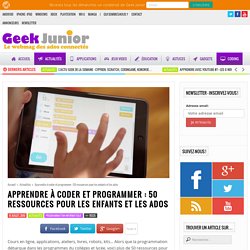
Alors que l’initiation à la programmation informatique débarque dans les programmes scolaires du lycée et du collège, de plus en plus d’initiatives voient le jour en France. Chaussures connectées - chaussures easyjet - IN VIVO. Mover Kit - The first active wearable that kids make & code by Technology Will Save Us. Risks and challenges Everyone says it; “hardware is hard”.
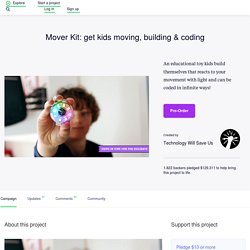
This is true, and we love it! For over three years we have been building a product business with hardware, software and kids at the center of it. We have shipped over 60,000 kits to over 97 countries and have designed a team around making sure we have control and partners to deliver the best end-to-end experience. From the out of the box experience, to our tight supply chain and our customer satisfaction and support. Of course, there is always the real possibility of things going wrong, and challenges do arise – which is why we have an experienced team of product designers, product managers, manufacturing specialists who are passionately building the best process to deliver the best products.
We will deliver the Mover Kit with the same detail, quality and robust educational resources as we have become known for. How Wooden Toys Teach Kids to Code. LIKE MOST PARENTS, I want my young children to be prepared for the future—one in which knowing how to program a computer will be a basic skill, like clicking “Skip Ad” on YouTube.
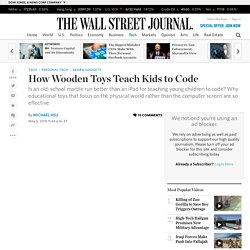
But as a longtime coder myself (I grew up on BASIC), I’ve been dismayed by the glut of “teach-your-kid-to-code” toys that focus on programming’s most mundane aspects. There’s more to it than dragging and dropping instructions around a screen. Most people who get into coding stick with it for one reason: They want to make cool stuff. Which is why I’m less concerned whether my children, who are all under 8, learn the mechanics of it than if they learn how to use technology to create whatever they can dream up.
Doing this doesn’t require sitting in front of a screen for hours. Mover Kit - The first active wearable that kids make & code by Technology Will Save Us. Jim Campbell at Bryce Wolkowitz, NYC (March 2014) Modell 'Haus-Elektroinstallation' - Opitec. Livecodelab. Soundplant: computer keyboard sample triggering for Windows & Mac. Videre - The Pop-Up Pinhole Company. Creative photography done bright. Pixelstick store.
Franc-parler - Fiche : Créer un roman-photo numérique. Accueil > Fiches pratiques Le roman-photo est de plus en plus employé dans le cadre de l’enseignement des langues pour travailler sur l’expression à travers l’image et le texte. Ce genre se prête particulièrement bien à la pédagogie de projet. Cette fiche vous propose de découvrir l’histoire du roman-photo et ses grandes caractéristiques, ainsi que les différentes étapes de sa création en classe. Sans titre. You've probably witnessed this tragic scenario before – a heavy crowd gathered around someone's smartphone, all of them vying for space, desperately trying to take in the latest Youtube spectacle. #firstworldproblems With the Cardboard Smartphone Projector at your disposal; these everyday videos of cats doing crazy stuff and babies falling over are now majestically transformed into glorious cinematic events, for everyone to enjoy.
Flossmanualsfr. Using the URLconf defined in fm_site.urls, Django tried these URL patterns, in this order: ^$ [name='home'] ^category/(? P<category>[\d+]+)/$ [name='category'] ^(? Art and Technology. Laura Poitras: Astro Noise. Laura Poitras: Astro Noise is the first solo museum exhibition by artist, filmmaker, and journalist Laura Poitras. This immersive installation of new work builds on topics important to Poitras, including mass surveillance, the war on terror, the U.S. drone program, Guantánamo Bay Prison, occupation, and torture. Some of these issues have been investigated in her films, including Citizenfour, which won the 2015 Academy Award for Best Documentary, and in her reporting, which was awarded a 2014 Pulitzer Prize. For the exhibition, Poitras is creating an interrelated series of installations in the Whitney’s eighth-floor Hurst Family Galleries.
The exhibition expands on her project to document post–9/11 America, engaging visitors in formats outside her non-fiction filmmaking. Laura Poitras: Astro Noise review – Citizenfour director loses the plot. Nearly three years after he flew to Hong Kong and released an unfathomable collection of classified information, we are still struggling to comprehend the scale of the disclosures of Edward Snowden. The NSA programs exposed in Snowden’s files are massive and largely illegal, and yet also bureaucratic and pathetically ineffective. How can we fathom the impunity, but also the futility, of apparatuses of data harvesting on a scale the Stasi could have only dreamed of? A team of reporters and editors here at the Guardian won the Pulitzer prize for their meticulous, months-long work bringing Snowden to scale. Yet Snowden’s first confidant was a film-maker, Laura Poitras, who documented her initial contact and subsequent collaboration with Snowden in Citizenfour, the third in a trilogy of feature documentaries on war and the security state.
Jim Campbell, Scattered Light. Bryce Wolkowitz Gallery. Bryce Wolkowitz gallery. Jim Campbell's Gloriously Low-Res Light Art. We live in a high resolution world. Just take, for example, a 4K television. This modern marvel of technology can display around 8 million pixels on its screen, compared with the measly 2 million we got with the regular HD variety. Analog Pixels – Les étonnants miroirs analogiques de l’artiste Daniel Rozin. Miroirs Interactifs par Daniel Rozin. L’artiste new-yorkais Daniel Rozin crée des installations étonnantes et des sculptures qui ont la capacité de répondre à la présence d’un observateur. Parmi ses œuvres les plus connues figure une série de miroirs interactifs construits à partir de tableaux complexes d’objets, comme des chevilles en bois, des bandes circulaires de bagues laminées, des rayons en plastique et même des morceaux de détritus.
Jim Campbell (biographie) Jim Campbell est né en 1956 à Chicago, en Illinois. Playing-with-led-matrices. ShiftOut. "Penguins Mirror" (2015) by Daniel Rozin. "Weave Mirror" (2007) by Daniel Rozin. Centro de Arte Reina Sofia. Jim campbell.